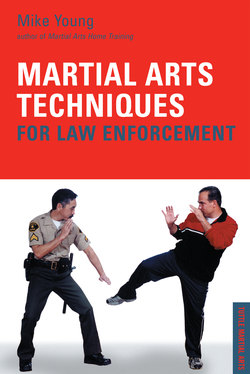Читать книгу Martial Arts Techniques for Law Enforcement - Mike Young - Страница 11
На сайте Литреса книга снята с продажи.
Оглавление2
Basic Rules for Self-Defense
In order to defend yourself successfully from physical attacks, you must first prepare yourself psychologically. The best martial arts training, physical ability, or reflexes in the world won’t help you if you’re not ready to use them when suddenly confronted with an aggressive assault. Physical assaults can never be taken too lightly—many officers have been injured or killed because they didn’t respond quickly enough to an assault.
In order to be properly prepared you must:
■ Be alert and ready to respond to an assault. You must first be alert to the potential for an assault in any given law enforcement situation. One way to stay prepared is through the constant mental rehearsal of “what-if” scenarios.
You must also know that you are ready to do anything reasonable to stop the assault. (As mentioned earlier, the key word here is reasonable. If all it takes is a palm heel strike to the assailant’s chest to stop the assault, then that is all that should be used. If the assailant continues to fight, multiple strikes or a takedown may be more appropriate.)
■ Be confident. You must have confidence in yourself, and in your physical and mental ability to overcome an assailant. The best way to build this self-confidence is through actual physical training in defensive tactics skills on a weekly basis.
■ Develop and use an effective “command voice.” In many cases, the use of a loud, deep, and confident command voice will stop an assault almost as soon as it’s started. I have used this approach many times with excellent results and without having to resort to physical force. One study shows that yelling at an assailant has a definite psychological effect—and could even prevent an attack. Many martial arts systems teach a kiai or “spirit shout” as a way of both deterring an attacker and giving the defender strength, power, and confidence. (This is why many warriors scream when going into battle.)
■ Be unafraid. Officers can get hurt, injured, or killed because they are afraid of the assailant, the situation, or of getting hurt. When dealing with an aggressive assailant, you must not be afraid; you must use proper tactics and take a positive proactive approach to subduing the assailant. You have many tools—besides your pure physical ability—at your disposal to help you deal with a physical encounter (baton, pepper spray, handcuffs, radio, sap, gloves, bulletproof vest, etc.).
■ Fight to win. Once you are engaged in a fight, the primary focus in your mind must be to fight to win. Your focus should be on conclusively defeating the attacker. Winning the fight is the best way to make sure that you can go home safely at the end of your shift. Giving up, or expecting your attacker to give up, could literally cause death.
Following these five basic rules will help you defend yourself in almost any situation. You should also:
■ React immediately. When attacked, you must immediately defend yourself and fight back.
■ Maintain eye contact with your assailant. Eye contact alone may intimidate some attackers.
■ Always watch the attacker’s hands. Your assailant may have a weapon.
■ Use your anger. Anger is a powerful drive that you can use constructively. Use your anger as a force to help you subdue your assailant.
■ Get trained in basic fighting skills. Develop the proper stability, distance, balance, speed, timing, and force.
■ Be flexible and innovative. Don’t think that there is just one way of doing things. Adapt to the situation and what’s working at that time, and then use it to your advantage.
■ Use physical and verbal distractions. You can sometimes stop a physical assault by physically or verbally distracting an assailant and then striking when the assailant is not physically or mentally ready.
■ Call for backup. Many assailants calm down once a call has been put through for backup. Even if they don’t, you’ll know that help is on the way.
■ Attack vulnerable areas. Striking assailants in their vulnerable areas will subdue them more effectively than striking them in a random, haphazard fashion.
Conditioning
Many officers still rely too heavily on their weapons or their numbers to get them out of dangerous situations, even though it’s well-known that an officer in good physical condition stands a better chance of handling an attacker. Unfortunately, situations can turn from tense to life threatening before you have time to retrieve your equipment or to get help. Therefore, all officers should incorporate physical conditioning into their self-defense training. Follow a balanced fitness regimen that includes regular aerobic conditioning, muscle conditioning, flexibility, coordination, and fighting combinations. This kind of training can be rigorous, so check with your doctor before starting.
